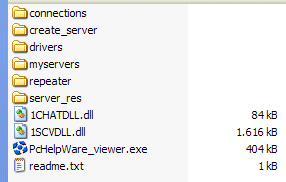PcHelpWare Introduction
Download PcHelpWare components (in Zip file format)
PcHelpWare is basically made of three parts:
- A Viewer that is used to remote control a distant PC
- A Server that runs on the distant PC
- An optional Repeater that helps the Viewer and the Server to connect together. It is actually a mediation-proxy service.
Viewer and Server can be customized to fit your needs (see Part 3, Part 4 and Customization pages)
PcHelpWare has two main connectivity schemes:
- Direct connection (can be used when only the server PC is behind a NAT router or simply not directly reachable) Server -> Viewer
- Connection through a repeater (can be used when both Viewer and Server PCs are behind their own NAT router) Server -> Repeater <- Viewer
Notes:
- PC standing behind a NAT means that this PC can't be easily reached from outside (from the Internet)
- You must run the Viewer on your machine. The individual you want to help must run the Server on his machine. Even if this machine is behind a NAT the connection can be done because this connection is initiated by the Server from behind the NAT router to the Viewer over the internet.
See Part 2 for more details on connection modes and settings.
PcHelpWare Zip file contents

> Folders
-
- Connections:
This folder is used the save Viewer profiles
- Create_server:
This folder contain the needed files to generate the customized Server exe
- Drivers:
If you wish to speedup your connections, you can install special Mirror Drivers under Windows 2000, XP and Vista.
- My Servers:
In this folder you find the generated Servers. The Servers are saved in a sub folder with the same name then the Viewer profile
- Repeater:
This folder contains the Repeater. An instance is most time running on the uvnc.com Server
- Server_res:
Contain the background and icon of the Server exe. Can be customized.

PcHelpware_viewer.exe
This is the profile name used to save the Viewer A "Direct Connection" is a connection between Server and Viewer, "Via Repeater" uses the repeater as a proxy List of saved Viewer profiles.

